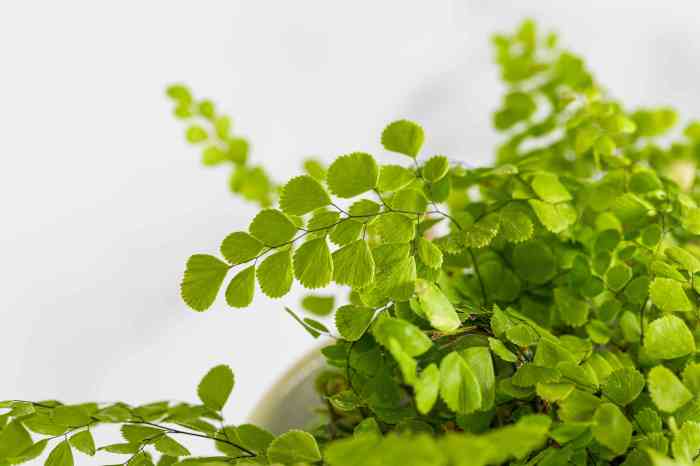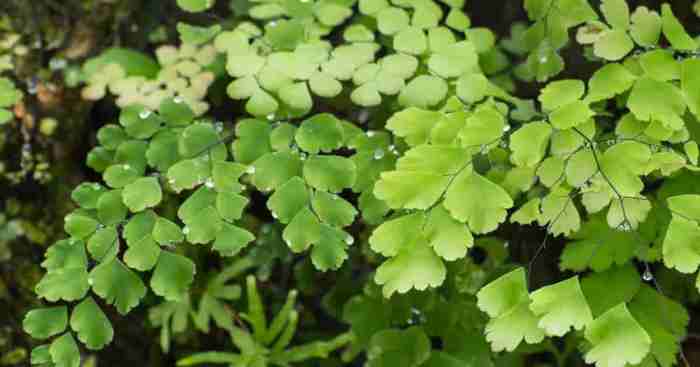Maidenhair ferns care – Delve into the enchanting world of maidenhair ferns and discover the secrets to their thriving existence. From understanding their ideal environment to addressing common challenges, this comprehensive guide will empower you to nurture these delicate beauties with confidence.
General Care and Maintenance

Maidenhair ferns (Adiantum spp.) are delicate and graceful plants that add a touch of elegance to any indoor space. However, they can be demanding to care for, as they have specific requirements for light, water, and humidity.
Light Requirements
Maidenhair ferns prefer bright, indirect light. Direct sunlight can scorch their leaves, while low light levels can cause them to become leggy and weak. If you are growing your maidenhair fern indoors, place it near a window that receives plenty of natural light but is not exposed to direct sunlight.
Watering and Fertilizing
Maidenhair ferns need to be kept moist at all times. Water your fern thoroughly when the top inch of soil feels dry to the touch. Do not allow the soil to dry out completely, as this can cause the fern to wilt and die.
During the growing season, fertilize your maidenhair fern monthly with a balanced liquid fertilizer.
Humidity Levels
Maidenhair ferns thrive in high humidity environments. If the air in your home is dry, you can increase the humidity around your fern by placing it on a tray filled with pebbles and water. The water will evaporate and create a humid environment around the fern.
Maidenhair ferns are a delicate and beautiful addition to any home, but they can be tricky to care for. If you’re looking for a more low-maintenance option, consider real hanging plants . These plants are typically more tolerant of neglect and can thrive in a variety of conditions.
However, if you’re still set on growing maidenhair ferns, be sure to provide them with plenty of humidity and indirect light.
Troubleshooting Common Issues
Maidenhair ferns are delicate plants that can suffer from various problems. Here are some common issues and how to address them:
Brown or Yellowing Fronds
Symptoms:Fronds turn brown or yellow, starting from the tips or edges.
When caring for maidenhair ferns, it’s crucial to maintain optimal moisture levels in their environment. If you’re seeking guidance on nurturing orchids, refer to Bunnings Orchid Soil: The Ultimate Guide to Nurturing Your Orchids . This comprehensive guide provides valuable insights into the specialized soil requirements of orchids.
Returning to maidenhair ferns, ensure regular misting and use a humidifier to create a humid microclimate that supports their delicate fronds.
Causes:
- Underwatering or overwatering
- Low humidity
- Excessive sunlight
- Nutrient deficiency
Root Rot
Symptoms:Soft, mushy roots; yellowing or wilting fronds; foul odor from the soil.
Causes:
- Overwatering
- Poor drainage
- Fungal infection
Pests
Aphids:Tiny, green or black insects that suck sap from fronds, causing yellowing and stunted growth.
Spider mites:Microscopic pests that create fine webs on the undersides of fronds, causing yellowing and leaf drop.
Mealybugs:Small, white, cottony insects that feed on the stems and fronds, causing yellowing and sticky residue.
Propagation and Repotting: Maidenhair Ferns Care

Propagating maidenhair ferns and repotting them are crucial aspects of their care. By following the right techniques, you can ensure the health and longevity of these delicate plants.
Propagation through Division, Maidenhair ferns care
Division is an effective method for propagating maidenhair ferns. It involves separating a mature plant into smaller sections, each with its own root system. The best time to divide maidenhair ferns is during spring or early summer, when they are actively growing.
- Gently remove the fern from its pot and shake off any excess soil.
- Use a sharp knife or spade to carefully divide the root ball into smaller sections, ensuring each section has a healthy root system.
- Plant the divisions in individual pots filled with a well-draining potting mix.
- Water the plants thoroughly and place them in a warm, humid location.
Repotting
Repotting is necessary when the maidenhair fern outgrows its current pot or when the potting mix becomes depleted. The best time to repot is during spring or early summer, when the plant is actively growing.
- Choose a pot that is slightly larger than the current one, with drainage holes.
- Fill the pot with a well-draining potting mix specifically designed for ferns.
- Carefully remove the fern from its old pot and gently loosen any tangled roots.
- Place the fern in the new pot and fill in the remaining space with potting mix.
- Water the plant thoroughly and place it in a warm, humid location.
Suitable Potting Mixes
Maidenhair ferns require a well-draining potting mix that provides adequate moisture and aeration. Here are some suitable options:
| Potting Mix | Description |
|---|---|
| Peat moss and perlite (1:1 ratio) | Provides good drainage and moisture retention. |
| Coconut coir and vermiculite (1:1 ratio) | Provides excellent drainage and aeration. |
| Commercial fern potting mix | Specifically formulated to meet the needs of ferns. |
Styling and Display

Maidenhair ferns, with their delicate fronds and graceful habit, offer versatile styling options to enhance any indoor or outdoor space. They can be used as hanging plants, creating a cascading effect that adds a touch of elegance and whimsy to a room.
Alternatively, they can be incorporated into arrangements with other plants, complementing their foliage and creating a lush, layered look.
Maidenhair ferns thrive in humid environments and require regular watering. To enhance their growth and aesthetics, consider placing them in Bunnings plant baskets . These baskets provide excellent drainage and aeration, promoting healthy root development. Additionally, they elevate the ferns, creating a more eye-catching display while ensuring optimal moisture levels for their delicate fronds.
Companion Plants
When selecting companion plants for maidenhair ferns, consider species that share similar growing conditions and complement their appearance. Ferns with contrasting textures, such as the broad fronds of Boston ferns or the upright growth of staghorn ferns, create visual interest and depth.
Plants with variegated foliage, such as the silver-striped Zebra plant or the pink-edged Fittonia, add a pop of color and draw attention to the delicate fronds of the maidenhair fern.
Incorporating Maidenhair Ferns
Maidenhair ferns thrive in humid environments, making them ideal for indoor spaces such as bathrooms, kitchens, and sunrooms. They can be placed on shelves, tables, or windowsills where they receive bright, indirect light. Outdoors, they prefer shaded areas under trees or in sheltered patios, where they can enjoy the dappled sunlight and humidity.
For those seeking to enhance the aesthetics of their maidenhair ferns, Bunnings Outdoor Ceramic Pots: A Comprehensive Guide to Styling Planting and Care offers valuable insights. This guide provides detailed information on selecting the ideal ceramic pots, planting techniques, and care tips to ensure optimal growth and lush foliage.
Whether you’re a seasoned gardener or a novice, this resource will guide you in creating a thriving indoor oasis for your delicate maidenhair ferns.
Closure

With proper care and attention, maidenhair ferns can grace your indoor and outdoor spaces with their ethereal elegance. Embrace the joy of cultivating these captivating plants, and witness their transformative power in creating a serene and verdant oasis.
FAQ Compilation
What is the ideal humidity level for maidenhair ferns?
Maidenhair ferns thrive in high humidity levels of around 50-60%. Regular misting or the use of a humidifier can help maintain the desired humidity.
How often should I water maidenhair ferns?
Water maidenhair ferns when the top inch of soil feels dry to the touch. Avoid overwatering, as soggy soil can lead to root rot.
What are common pests that affect maidenhair ferns?
Common pests include aphids, mealybugs, and spider mites. Regular inspection and prompt treatment with insecticidal soap or neem oil can help control infestations.